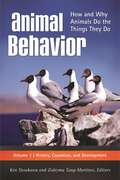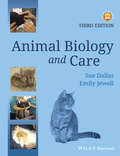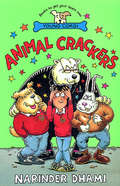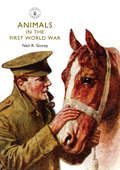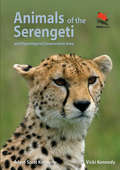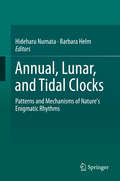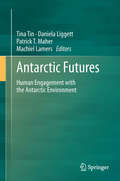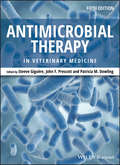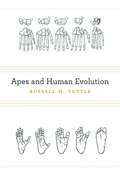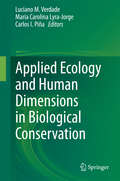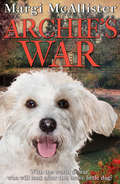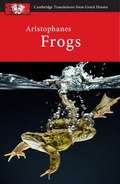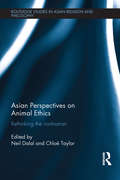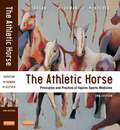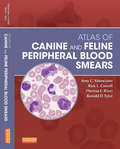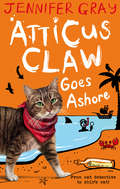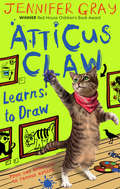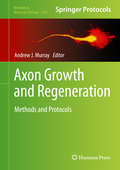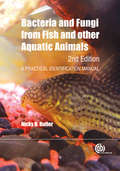- Table View
- List View
Animal Behavior [3 volumes]: How and Why Animals Do the Things They Do [3 volumes]
by Alison M. Bell Andrew P. King Anna Dornhaus Anne Danielson-François Anthony C. Little Benedict C. Jones Bennett G. Galef Brett M. Gibson Brian Keane Bronwyn H. Bleakley Çağlar Akçay Carolynn L. Smith Catherine A. Marler Charles T. Snowdon Christopher D. Watkins Christopher Harshaw Christopher S. Evans David B. Mcdonald David Clark David Crews David F. Sherry David J. White Douglas W. Mock Geoffrey E. Hill George Uetz Guillermo Paz-Y-Miño-c James L. Gould Janis L. Dickinson Jason Low Jeffrey R. Alberts Ken Yasukawa Kenyon B. Mobley Laura Smale Lee Alan Dugatkin Lee C. Drickamer Lisa M. Debruine Mark E. Hauber Matthew J. Fuxjager Megan Hastings Hagenauer Meredith J. West Michael D. Beecher Michael J. Ryan Michelle Pellissier Scott Nancy G. Solomon Rachel A. Page Renée A. Duckworth S. Craig Roberts Sarah Jane Alger Sean P. Bradley Terry J. Ord Theodore Stankowich Walter D. Koenig Ximena E. Bernal Zenobia Lewis Zuleyma Tang-MartínezDiscover why animals do what they do, based on their genes, physiologies, cultures, traditions, survival and mating advantages, and evolutionary histories—and find out how studying behavior in the animal world helps us understand human behavior.The three volumes of Animal Behavior: How and Why Animals Do the Things They Do cover the breadth of the field, addressing causation, development, function, and evolution in a wide range of animals, from invertebrates to humans. Inspired by Nobel laureate Nikolaas Tinbergen's work, the first two volumes follow Tinbergen's four classic questions of animal behavior, while the third volume supplies integrated examples of Tinbergen's investigative process applied in specific cases.Written in an engaging, accessible manner ideal for college students as well as general audiences, this evidence-based collection provides a fascinating tour of animal behaviorists' findings, such as how animal communication can be truthful or deceitful, the deadly serious business behind clashes in the "battle of the sexes," and how documentation of animal behavior can lead to a deeper understanding of human behavior. Each chapter provides both historical background and information about current developments in animal behavior knowledge.
Animal Biology and Care
by Sue Dallas Emily JewellThe perfect study companion, Animal Biology and Care, 3rd Edition is specifically designed for students on animal care, animal nursing assistant and veterinary care assistant courses. This edition is fully updated with new course content, a refreshed design and colour illustrations throughout. Basic biological theory is introduced with diagrams for visual learners while photographs demonstrate the common practical procedures carried out by animal care assistants. Key features include: New content on exotic species, recognising the increasing number of these animals kept as pets. Extensive coverage of the Animal Welfare Act 2006 and recent advances in animal welfare. Written in line with course curricula, chapter summaries help you to remember key points and learning objectives. A companion website has interactive MCQs to help you test your knowledge. Divided into three main sections covering animal science and genetics, health and husbandry and nursing procedures, this book will help lay the foundations for a successful career in animal care and management!
Animal Biology and Care
by Sue Dallas Emily JewellThe perfect study companion, Animal Biology and Care, 3rd Edition is specifically designed for students on animal care, animal nursing assistant and veterinary care assistant courses. This edition is fully updated with new course content, a refreshed design and colour illustrations throughout. Basic biological theory is introduced with diagrams for visual learners while photographs demonstrate the common practical procedures carried out by animal care assistants. Key features include: New content on exotic species, recognising the increasing number of these animals kept as pets. Extensive coverage of the Animal Welfare Act 2006 and recent advances in animal welfare. Written in line with course curricula, chapter summaries help you to remember key points and learning objectives. A companion website has interactive MCQs to help you test your knowledge. Divided into three main sections covering animal science and genetics, health and husbandry and nursing procedures, this book will help lay the foundations for a successful career in animal care and management!
Animal Crackers
by Narinder DhamiWhen Sanjay gets a bump on his head from the school bully, he wakes up to find that everyone in the playground has turned into an animal! The headmaster's a polar bear and Sanjay's best friend is a sheepdog. Even the ambulance that comes to take him to hospital is driven by a gorilla and the paramedic is a penguin...Seeing his schoolmates in a new light gives Sanjay a clever idea about how to defeat the bully... Will Sanjay's wily plan work, or has the whole world gone animal crackers?
Animals in the First World War (Shire Library #790)
by Neil R. StoreyThe burden of the Great War was not shouldered by soldiers alone: the tasks, the camaraderie, the day-to-day life and the devastation were all shared with the animals that accompanied the forces abroad. The horses that took part in the last cavalry charges or hauled heavy guns are the most famous examples, but were far from alone: pigeons carried vital messages, dogs sniffed out wounded soldiers, camels were used as beasts of burden in the desert, and even ships' cats and baby orang-utans had their parts to play. From noted historian Neil R. Storey, this book looks at all the practical ways in which animals were essential to the war effort, but is equally interested in their roles as companions, mascots and morale boosters – on land, in the air and at sea. Neil R. Storey is a social and military historian specialising in the impact of war on society. He has written over twenty-five books, countless articles and has given lectures across the UK, including at the Imperial War Museum. He has acted as a consultant on a number of television documentaries and dramas.
Animals of the Serengeti: And Ngorongoro Conservation Area (PDF)
by Adam Scott Kennedy Vicki KennedyContaining 146 stunning color photos, Animals of the Serengeti is a remarkable look at the mammals and reptiles most likely to be encountered in the world-famous Serengeti National Park and Ngorongoro Crater. With an eye-catching layout, accessible text, and easy-to-use format, this detailed photographic guide includes 89 species of mammal and reptile. Useful "Top Tips"—shared by local Tanzanian guides that work in the region—provide visitors with insights into behavioral habits and how to locate specific animals. Filled with vivid anecdotes, Animals of the Serengeti will enable any safari traveler to identify the area's wildlife with ease.Covers the 89 species likely to be encountered in Tanzania’s Serengeti National Park and Ngorongoro Conservation Area Features male and female variationsAccessible text aimed at safari visitors of all levels
Annual, Lunar, and Tidal Clocks: Patterns and Mechanisms of Nature's Enigmatic Rhythms
by Hideharu Numata Barbara HelmThere is more to biological rhythms than circadian clocks. This book aims at promoting the exciting potential of a deeper understanding of circannual, circatidal, and circalunar clocks. It highlights new developments, summarizes existing knowledge, and integrates different perspectives with the tools and ideas of diverse fields of current biology.For predominantly pragmatic reasons, research in recent decades was mostly concerned with circadian clocks. Clocks on other timescales, however, have been largely neglected and therefore still appear "enigmatic". Thanks to the rapid development of methods in molecular biology as well as in ecology, we are now able to re-approach these clocks. Laboratories around the world are showing fresh interest and substantial progress is being made in many independent projects. The book's two sections address the moon-derived circatidal, circasemilunar, and lunar cycles on the one hand (10 chapters), and the sun-derived circannual cycles on the other (6 chapters). This work brings together authors with an expansive array of expertise and study systems, ranging from tidal cycles of marine invertebrates to annual cycles of birds and mammals, and from behavioral to genetic and epigenetic backgrounds. While great challenges remain to be mastered, the book aims at conveying the excitement of unraveling, broadly, the rhythms of life.
Ant and Bee and the ABC (Ant and Bee)
by Angela BannerThe much-loved classic series of Ant and Bee books is designed for shared reading fun! First published in 1950, Ant and Bee were in print for over 40 years. These new editions feature revised text and illustrations by original Ant and Bee creator Angela Banner. The adorably small format is perfect for little hands.
Ant and Bee and the Doctor (Ant and Bee)
by Angela BannerThe much-loved classic series of Ant and Bee books is designed for shared reading fun! First published in 1950, Ant and Bee were in print for over 40 years. These new editions feature revised text and illustrations by original Ant and Bee creator Angela Banner. The adorably small format is perfect for little hands.
Antarctic Futures: Human Engagement with the Antarctic Environment
by Tina Tin Daniela Liggett Patrick T Maher Machiel LamersAt the beginning of the 21st century, Antarctica is poised at the edge of a warmer and busier world. Leading Antarctic researchers examine the needs and challenges of Antarctic environmental management today and tomorrow. Through: (i) investigating the impacts of human activities on specific ecosystems and species, (ii) examining existing environmental management and monitoring practices in place in various regions and (iii) interrogating stakeholders, they address the following questions: What future will Business-As-Usual bring to the Antarctic environment? Will a Business-As-Usual future be compatible with the objectives set out under the Antarctic Treaty, especially its Protocol on Environmental Protection? What actions are necessary to bring about alternative futures for the next 50 years? This volume is an outcome of the International Polar Year (2007-2009) Oslo Science Conference (8-12, June, 2010).
Antimicrobial Therapy in Veterinary Medicine
by Steeve Giguère John F. Prescott Patricia M. DowlingThe Fifth Edition of Antimicrobial Therapy in Veterinary Medicine, the most comprehensive reference available on veterinary antimicrobial drug use, has been thoroughly revised and updated to reflect the rapid advancements in the field of antimicrobial therapy. Encompassing all aspects of antimicrobial drug use in animals, the book provides detailed coverage of virtually all types of antimicrobials relevant to animal health. Now with a new chapter on antimicrobial therapy in zoo animals, Antimicrobial Therapy in Veterinary Medicine offers a wealth of invaluable information for appropriately prescribing antimicrobial therapies and shaping public policy. Divided into four sections covering general principles of antimicrobial therapy, classes of antimicrobial agents, special considerations, and antimicrobial drug use in multiple animal species, the text is enhanced by tables, diagrams, and photos. Antimicrobial Therapy in Veterinary Medicine is an essential resource for anyone concerned with the appropriate use of antimicrobial drugs, including veterinary practitioners, students, public health veterinarians, and industry and research scientists.
Antimicrobial Therapy in Veterinary Medicine
by Steeve Giguère John F. Prescott Patricia M. DowlingThe Fifth Edition of Antimicrobial Therapy in Veterinary Medicine, the most comprehensive reference available on veterinary antimicrobial drug use, has been thoroughly revised and updated to reflect the rapid advancements in the field of antimicrobial therapy. Encompassing all aspects of antimicrobial drug use in animals, the book provides detailed coverage of virtually all types of antimicrobials relevant to animal health. Now with a new chapter on antimicrobial therapy in zoo animals, Antimicrobial Therapy in Veterinary Medicine offers a wealth of invaluable information for appropriately prescribing antimicrobial therapies and shaping public policy. Divided into four sections covering general principles of antimicrobial therapy, classes of antimicrobial agents, special considerations, and antimicrobial drug use in multiple animal species, the text is enhanced by tables, diagrams, and photos. Antimicrobial Therapy in Veterinary Medicine is an essential resource for anyone concerned with the appropriate use of antimicrobial drugs, including veterinary practitioners, students, public health veterinarians, and industry and research scientists.
Apes and Human Evolution
by Russell H. TuttleIn this masterwork, Russell H. Tuttle synthesizes a vast research literature in primate evolution and behavior to explain how apes and humans evolved in relation to one another, and why humans became a bipedal, tool-making, culture-inventing species distinct from other hominoids. Along the way, he refutes the theory that men are essentially killer apes--sophisticated but instinctively aggressive, destructive beings. Situating humans in a broad context, Tuttle musters evidence from morphology and recent fossil discoveries to reveal what early primates ate, where they slept, how they learned to walk upright, how brain and hand anatomy evolved simultaneously, and what else happened evolutionarily to cause humans to diverge from their closest relatives. Despite our genomic similarities with bonobos, chimpanzees, and gorillas, humans are unique among primates in occupying a symbolic niche of values and beliefs based on symbolically mediated cognitive processes. Although apes exhibit behaviors that strongly suggest they can think, salient elements of human culture--speech, mating proscriptions, kinship structures, and moral codes--are symbolic systems that are not manifest among apes. This encylopedic volume is both a milestone in primatological research and a critique of what is known and yet to be discovered about human and ape potential.
Apes and Human Evolution
by Russell H. TuttleIn this masterwork, Russell H. Tuttle synthesizes a vast research literature in primate evolution and behavior to explain how apes and humans evolved in relation to one another, and why humans became a bipedal, tool-making, culture-inventing species distinct from other hominoids. Along the way, he refutes the theory that men are essentially killer apes--sophisticated but instinctively aggressive, destructive beings. Situating humans in a broad context, Tuttle musters evidence from morphology and recent fossil discoveries to reveal what early primates ate, where they slept, how they learned to walk upright, how brain and hand anatomy evolved simultaneously, and what else happened evolutionarily to cause humans to diverge from their closest relatives. Despite our genomic similarities with bonobos, chimpanzees, and gorillas, humans are unique among primates in occupying a symbolic niche of values and beliefs based on symbolically mediated cognitive processes. Although apes exhibit behaviors that strongly suggest they can think, salient elements of human culture--speech, mating proscriptions, kinship structures, and moral codes--are symbolic systems that are not manifest among apes. This encylopedic volume is both a milestone in primatological research and a critique of what is known and yet to be discovered about human and ape potential.
Applied Ecology and Human Dimensions in Biological Conservation
by Luciano M. Verdade Maria Carolina Lyra-Jorge Carlos I. PiñaThis book provides both the conceptual basis and technological tools that are necessary to identify and solve problems related to biodiversity governance. The authors discuss intriguing evolutionary questions, which involve the sometimes surprising adaptive capacity of certain organisms to dwell in altered and/or changing environments that apparently lost most of their structure and functionality. Space and time heterogeneities are considered in order to understand the patterns of distribution and abundance of species and the various processes that mold them. The book also discusses at which level—from genes to the landscape, including individuals, populations, communities, and ecosystems—men should intervene in nature in order to prevent the loss of biodiversity.
Archie's War
by Margi McAllisterA servant boy, a dog and a war that shook the world. Margi's latest has all its cannons blazing. Archie's family work on an aristocrat's country estate. When the First World War breaks out, Archie is asked to look after the dog of Master Edward, who has been called up to fight. An unbreakable bond soon grows between Archie and Star, the scruffy white terrier. So when Archie's big brother runs away to join the army, Archie and Star set off to find him. Facing many dangers, can they bring him home? A wonderful animal story and a great read for Remembrance Day.
Aristophanes: Frogs (Cambridge Translations From Greek Drama (PDF)Ser.)
by Judith Affleck Clive Letchford John HarrisonTreating ancient plays as living drama. Classical Greek drama is brought vividly to life in this series of new translations. Students are encouraged to engage with the text through detailed commentaries, including suggestions for discussion and analysis. Numerous practical questions stimulate ideas on staging and encourage students to explore the play's dramatic qualities. Frogs is suitable for students of Classical Civilisation and Drama. Features include a full synopsis of the play, commentary alongside translation for easy reference and a comprehensive introduction to the Greek Theatre. Frogs is aimed at A-level and undergraduate students in the UK, and college students in North America.
Asian Perspectives on Animal Ethics: Rethinking the Nonhuman
by Neil Dalal Chloë TaylorTo date, philosophical discussions of animal ethics and Critical Animal Studies have been dominated by Western perspectives and Western thinkers. This book makes a novel contribution to animal ethics in showing the range and richness of ideas offered to these fields by diverse Asian traditions. Asian Perspectives on Animal Ethics is the first of its kind to include the intersection of Asian and European traditions with respect to human and nonhuman relations. Presenting a series of studies focusing on specific Asian traditions, as well as studies that put those traditions in dialogue with Western thinkers, this book looks at Asian philosophical doctrines concerning compassion and nonviolence as these apply to nonhuman animals, as well as the moral rights and status of nonhuman animals in Asian traditions. Using Asian perspectives to explore ontological, ethical and political questions, contributors analyze humanism and post-humanism in Asian and comparative traditions and offer insight into the special ethical relations between humans and other particular species of animals. This book will be of interest to students and scholars of Asian religion and philosophy, as well as to those interested in animal ethics and Critical Animal Studies.
Asian Perspectives on Animal Ethics: Rethinking the Nonhuman
by Neil Dalal Chloë TaylorTo date, philosophical discussions of animal ethics and Critical Animal Studies have been dominated by Western perspectives and Western thinkers. This book makes a novel contribution to animal ethics in showing the range and richness of ideas offered to these fields by diverse Asian traditions. Asian Perspectives on Animal Ethics is the first of its kind to include the intersection of Asian and European traditions with respect to human and nonhuman relations. Presenting a series of studies focusing on specific Asian traditions, as well as studies that put those traditions in dialogue with Western thinkers, this book looks at Asian philosophical doctrines concerning compassion and nonviolence as these apply to nonhuman animals, as well as the moral rights and status of nonhuman animals in Asian traditions. Using Asian perspectives to explore ontological, ethical and political questions, contributors analyze humanism and post-humanism in Asian and comparative traditions and offer insight into the special ethical relations between humans and other particular species of animals. This book will be of interest to students and scholars of Asian religion and philosophy, as well as to those interested in animal ethics and Critical Animal Studies.
The Athletic Horse - E-Book: Principles and Practice of Equine Sports Medicine
by David R. Hodgson Catherine M. McGowan Kenneth McKeeverShowing how to maximize performance in horses, The Athletic Horse: Principles and Practice of Equine Sports Medicine, 2nd Edition describes sports training regimens and how to reduce musculoskeletal injuries. Practical coverage addresses the anatomical and physiological basis of equine exercise and performance, centering on evaluation, imaging, pharmacology, and training recommendations for sports such as racing and show jumping. Now in full color, this edition includes new rehabilitation techniques, the latest imaging techniques, and the best methods for equine transportation. Written by expert educators Dr. David Hodgson, Dr. Catherine McGowan, and Dr. Kenneth McKeever, with a panel of highly qualified contributing authors.Expert international contributors provide cutting-edge equine information from the top countries in performance-horse research: the U.S., Australia, U.K., South Africa, and Canada.The latest nutritional guidelines maximize the performance of the equine athlete.Extensive reference lists at the end of each chapter provide up-to-date resources for further research and study. NEW full-color photographs depict external clinical signs, allowing more accurate clinical recognition.NEW and improved imaging techniques maximize your ability to assess equine performance.UPDATED drug information is presented as it applies to treatment and to new regulations for drug use in the equine athlete.NEW advances in methods of transporting equine athletes ensure that the amount of stress on the athlete is kept to a minimum.NEW rehabilitation techniques help to prepare the equine athlete for a return to the job.Two NEW authors, Dr. Catherine McGowan and Dr. Kenneth McKeever, are highly recognized experts in the field.
Atlas of Canine and Feline Peripheral Blood Smears - E-Book: Atlas Of Canine And Feline Peripheral Blood Smears (Small Animal Laboratory Essentials)
by Ms, Dacvp, Rick L. Cowell, Dvm, Ms, Mrcvs, Dacvp Dvm, Ms, Dacvp, Rick L. Cowell, DvmAn illustrated guide to the morphology of blood cells, Atlas of Canine and Feline Peripheral Blood Smears covers patient assessment for common hematologic disorders and diseases in dogs and cats. Over 1,000 full-color photomicrographs depict abnormalities within each blood cell line, with multiple pictures of each morphologic abnormality and variations in their appearance. Written by pathology experts Amy Valenciano, Rick Cowell, Theresa Rizzi, and Ronald Tyler, this concise reference will enhance your skills as you interpret blood smears and recognize hematological cellular response to inflammation, infection, and toxicity. "Everything you might encounter looking at dog or cat blood smears is right there, clearly classified and noted (more than 1000 pictures!). Pitfalls and artefacts are clearly explained. The format (spiral binding) makes it the obvious accessory for your microscope. A good investment." Reviewed by: Vet's Today Date: July 2014Over 1,000 photomicrographs facilitate microscopic analysis and interpretation of the cellular components of the blood.Full-color, high-resolution images facilitate identification of different blood cell types, numbers, anomalies and conditions.Multiple representations of morphologic abnormalities aid in recognition of conditions where variations in appearance commonly occur.Practical information includes an overview of laboratory methods, equipment and supplies, sample collection, staining and handling, and diagnostic interpretation of blood smears.Coverage of 125 topics ranges from the morphology of erythrocytes to chronic myeloid leukemia. Spiral binding allows the book to lay open next to the microscope, making it a quick and easy reference while on the job.
Atticus Claw Goes Ashore (Atticus Claw: World's Greatest Cat Detective #4)
by Jennifer GrayAtticus is on beach tidying duty with the kittens when he finds a message in a bottle from Fishhook Frank. Fishhook is marooned on a desert island, but he promises Atticus treasure in exchange for his rescue! The treasure in question is the Casket of Desires, which contains a sleeping mermaid who has the power to grant any wish. But it is hidden in the deepest darkest part of the ocean, protected by the most hideous, fearsome sea-creatures known to pirate lore. Atticus sets out to rescue Fishhook Frank and find the Casket of Desires with his owners, the Cheddar family. But it's not all plain sailing. The pirate with the biggest beard-jumper in the nautical world - Captain Black Beard-Jumper - is also on the look out for the Casket and he'll curse anyone who gets in his way...
Atticus Claw Learns to Draw (Atticus Claw: World's Greatest Cat Detective #5)
by Jennifer GrayAtticus Claw Leans to Draw by Jennifer Gray is the latest in this popular series about master-criminal turned police-cat, Atticus Claw.Famous works of art are going missing. Atticus is on the case. The prime suspect is Ricardo Butteredsconi - Italian theme park entrepreneur and art connoisseur. Then Inspector Cheddar goes missing from the Tate Modern, and Atticus and his friends suspect Butteredsconi and his evil pet pig. In the scariest adventure of his nine lives, Atticus has to act fast if he wants to stop Inspector Cheddar becoming a waxwork!'Should be a hit for anyone who is, or has been, ten years old.' The Bookbag'Worth it for the delightfully feline puns alone.' Herald'As many ups and downs, triumphs and disasters, thrills and spills as ever.' Carousel'Atticus Claw is a masterpiece!' Sam, age 12'Very funny and interesting.' Aram age 9'Atticus is naughty and really cool!' Lucas, age 7'Atticus Claw is fantastic.' Charlotte, age 8
Axon Growth and Regeneration: Methods and Protocols (Methods in Molecular Biology #1162)
by Andrew J. MurrayAxon Growth and Regeneration: Methods and Protocols brings together a diverse set of techniques for the study of the mechanisms underlying central nervous system axon growth, consequently providing a resource that will aid in the development of repair strategies. After an introductory section, this detailed volume continues with sections focusing on axon growth in vitro, providing a range of protocols that can be used to examine intracellular signalling pathways, axonal responses to extracellular factors and methods for quantifying outgrowth. The next section provides protocols for inducing experimental injury in vivo as well as some highly promising protocols for promoting regeneration, which segues into the final section highlighting a series of protocols that can be used to monitor the extent of axon regeneration in vivo, ranging from tract tracing to in vivo imaging and functional recovery. As a book in the Methods in Molecular Biology series, chapters contain introductions to their respective topics, lists of the necessary materials and reagents, step-by-step, readily reproducible laboratory protocols and tips on troubleshooting and avoiding known pitfalls.Practical and reliable, Axon Growth and Regeneration: Methods and Protocols aims to serve researchers studying axon regeneration with a significant set of diverse tools, vital for moving on to the next generation of exciting new discoveries in the field.
Bacteria and Fungi from Fish and Other Aquatic Animals: A Practical Identification Manual
by Nicky BullerThis practical book provides an updated resource for the identification of bacteria found in animals inhabiting the aquatic environment, illustrated with colour photos. It contains expanded biochemical identification tables to include newly identified pathogenic and saprophytic bacteria, molecular identification tests now available for a greater number of aquatic bacterial pathogens, more information on the pathogenesis and virulence of each organism and new coverage of traditional and molecular identification of fungal pathogens and quality assurance standards for laboratories.
